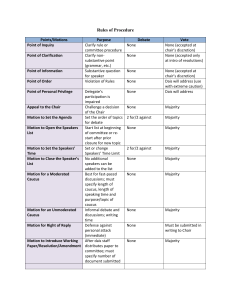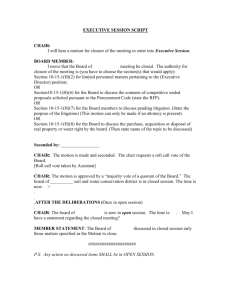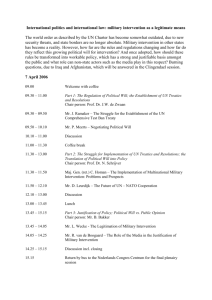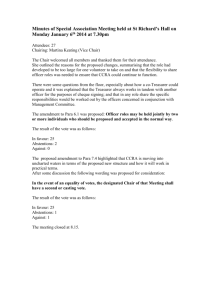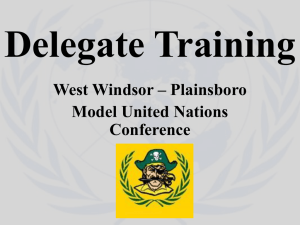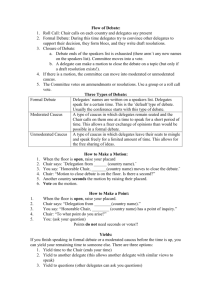Rules of Procedure - TJHSST Activities
advertisement
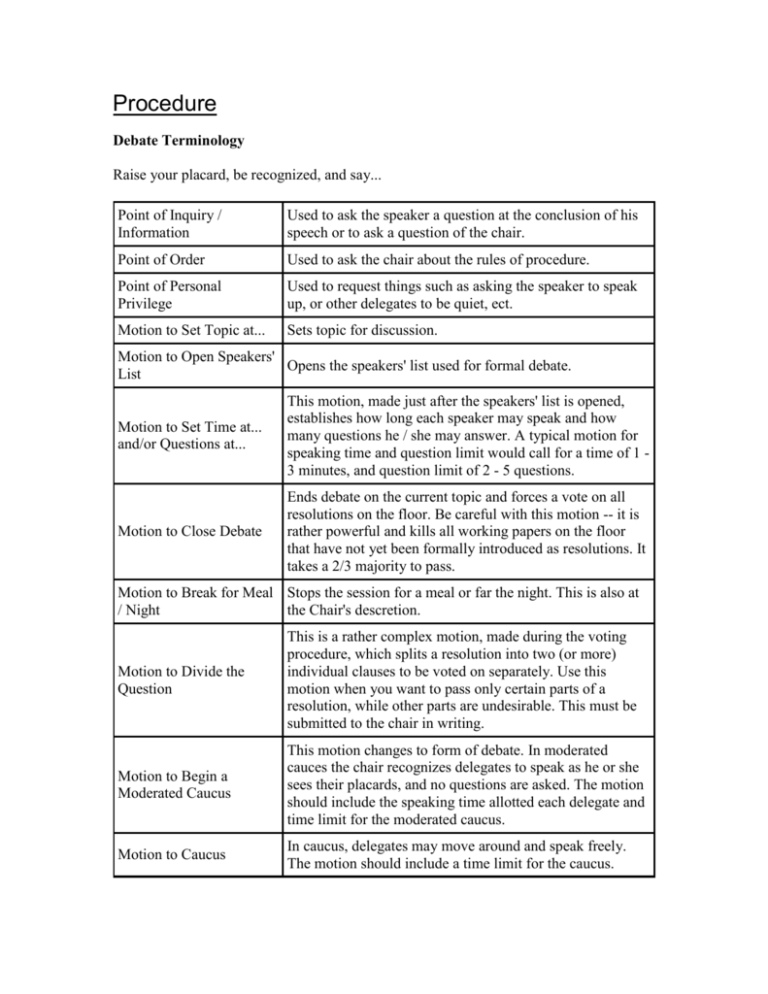
Procedure Debate Terminology Raise your placard, be recognized, and say... Point of Inquiry / Information Used to ask the speaker a question at the conclusion of his speech or to ask a question of the chair. Point of Order Used to ask the chair about the rules of procedure. Point of Personal Privilege Used to request things such as asking the speaker to speak up, or other delegates to be quiet, ect. Motion to Set Topic at... Sets topic for discussion. Motion to Open Speakers' Opens the speakers' list used for formal debate. List Motion to Set Time at... and/or Questions at... This motion, made just after the speakers' list is opened, establishes how long each speaker may speak and how many questions he / she may answer. A typical motion for speaking time and question limit would call for a time of 1 3 minutes, and question limit of 2 - 5 questions. Motion to Close Debate Ends debate on the current topic and forces a vote on all resolutions on the floor. Be careful with this motion -- it is rather powerful and kills all working papers on the floor that have not yet been formally introduced as resolutions. It takes a 2/3 majority to pass. Motion to Break for Meal Stops the session for a meal or far the night. This is also at / Night the Chair's descretion. Motion to Divide the Question This is a rather complex motion, made during the voting procedure, which splits a resolution into two (or more) individual clauses to be voted on separately. Use this motion when you want to pass only certain parts of a resolution, while other parts are undesirable. This must be submitted to the chair in writing. Motion to Begin a Moderated Caucus This motion changes to form of debate. In moderated cauces the chair recognizes delegates to speak as he or she sees their placards, and no questions are asked. The motion should include the speaking time allotted each delegate and time limit for the moderated caucus. Motion to Caucus In caucus, delegates may move around and speak freely. The motion should include a time limit for the caucus. Rules of Procedure 1. Functions of the Chair: The Chair is responsible for facilitating debate and for enforcing these rules of procedure. The Chair will rule on points of order, put question to votes, announce decisions, and recognize speakers. The Chair may use discretion to alter the rules of procedure in whatever manner he or she deems necessary to enhance the debate. The Chair will maintain order in the committee. 2. Quorum: At least one quarter of any committee must be present in order to open debate. A majority is required before a resolution may be held. Quorum will be assumed to be present unless challenged by a member of the committee. 3. Setting of the Agenda: A motion to set a topic requires two speakers for two speakers against. A simple majority of present delegations is necessary for passage. If accepted, the committee will immediately enter formal voting procedure on all resolutions and amendments that have been introduced. 4. Closure of Debate: A motion to close debate requires two speakers for and two speakers against. A two thirds majority of present delegations is necessary for passage. If accepted, the committee will immediately enter formal voting procedure on all resolutions and amendments that have been introduced. 5. Tabling of Debate: A motion to table debate requires two speakers for and two speakers against. A two thirds majority of present delegations is necessary for passage. If debate on a topic is table, the agenda will be considered undeterminded and resolutions and amendments will not be voted on. Discussion of table topics may be resumed at a later time. 6. Speeches: No delegate may speak in formal debate until recognized by the chair. The chair will maintain a speaker's list for those wishing to speak after it is motioned open by the committee. Each topic will have a separate speaker's list. 7. Time Limits: Time and question limits may be set by the committee. They require a simple majority. 8. Yields: Should a speaker choose, he or she may yield time in one of three ways. If time is yielded to the chair, the delegate will give up the floor. If time is yielded to questions, the chair will entertain questions fromt he body for the speaker until the question limit is exhausted. Time yielded to another delegation may be used on to speak. No questions are allowed after a yield to another delegation. 9. Rights of Reply: Should a delegate feel that his honor or that of country has been insulted by a speaker, he may submit a motion for a right of reply to the chair in writing. If the chair agrees, the chair shall grant time for the insulted delegate to address the speaker's comments. This motion is rarely granted as delegates are almost always courteous. 10. Point of Parliamentary Procedure: A delegate may rise with this point if confused or unsure of the rules of procedure. Such a point may not interrupt a speaker. 11. Point of Personal Privilege: If physically uncomfortable or unable to hear the speaker, a delegate may rise to this point. Such a point may interrupt a speaker. 12. Point of Order: A delegate may rise to this point to bring a rule infractoin to the attention of the chair. It may only be used to interrupt a speaker if the speech violate parliamentary procedure. 13. Caucusing: A motion for a caucus is in order whenever the floor is opena dn formal debate is in effect. It must specify a time limit and may be followed by a brief explanation of it s purpose. A simple majority vote is required for it passage. 14. Moderated Caucusing: A moderated caucus is proposed similarly to a regular cauces. It must specify a total time and may include a time limit for individual speakers. During a moderated caucus the chair will recognize those wishing to speak at random. There are no questionson speeches given during a moderated caucus. 15. Resolutions: Any document meeting the requirements of a formal resolution, which includes the signatures of at tleast one fifth of the assembled committee, may be submitted as a resolution. Signature does not imply support. Each document submitted as a resolution must be sponsored by one or more delegations. Sponsors are assumed to have contributed the bulk of a resolution and to be in support of it. After submission the chair will review the document. If it meets the necessary requirements any sponsor may formally introduce it as a resolution when the delegate has the floor in formal debate. The time required to read the resolution and to answer points of clarification only will not be counted against the speaker's time limit. 16. Amendments: Amendments may be introduced to any formal resolution. Each must have the signature of one fifth of the body in order to be considered. If all sponsors to the resolution being amended state that the amendment is friendly, it will be automatically added to te resolution. If any sponsor considers the amendment unfriendly, it can be added to teh resolution by a majority vote of the committee. 17. Voting Procedure: Formal voting procedure may only be entered into by closing debate. During voting procedure, the doors will be shut and no moving about or speaking by the delegates will be permissible. All formally introduced resolutions will be voted on in the order of introduction unless otherwise motioned for and voted for by a majority vote of the committee. Incorportation of unfrendly amendments will be voted on immediately before the resolution to which they apply. A simple placard vote will be taken on each item unless a roll call vote is requested. Teh passage ofresolution on specialized committees (like the Security Council, which has five veto nations) may be subject to different requirements. 18. Roll Call Voting: Should any delegate motion for a roll call vote on a resolution, such a vote will automatically be taken, subject to the chair's discretion. During a roll call vote, the chair will ask for the vote of each delegation in alphabetical order. Delegates may reply either yes, no, abstain, yes with rights, no with rights, or pass. The chair will call again on all nations who pass ofter proceeding through the committee. Each nation that has passed will then vote either yes or no, with no abstentions allowed. Voters with rights of explanation will be granted thirty seconds following the vote to explain why their nation voted in apparent contradiction with its policy. 19. Division of the Question: This motion is in order after debate ona topic has been closed but before the resolution to which it applies is voted on. It must specify those parts of the resolution to be voted on apart from the resolution body. A simple majority vote will divide the resolution into two parts to be voted on separately. 20. Adjournment of the Meeting: This motion requires a simple majority vote to pass. When passed, the committee will be suspended until the next session, if there is one. 21. Motion to Vote on Competency: Should a delegate feel that the topic under discussion is outside the jurisdiction of the Committee or is more apporopriate for another committee, he or she may bring the topic to a vote of competency. The vote requires a 2 / 3 majority to end all further debate on the topic.
